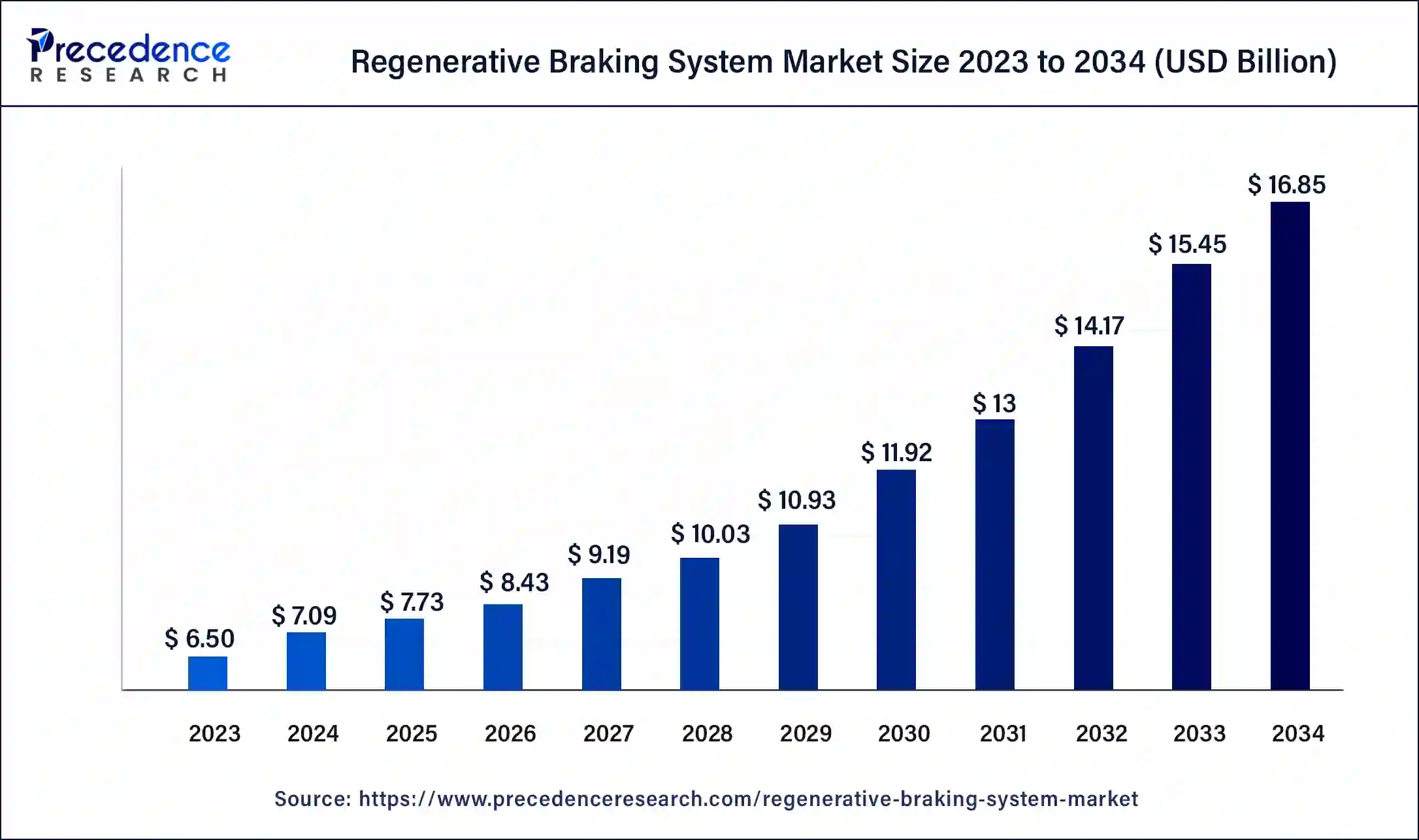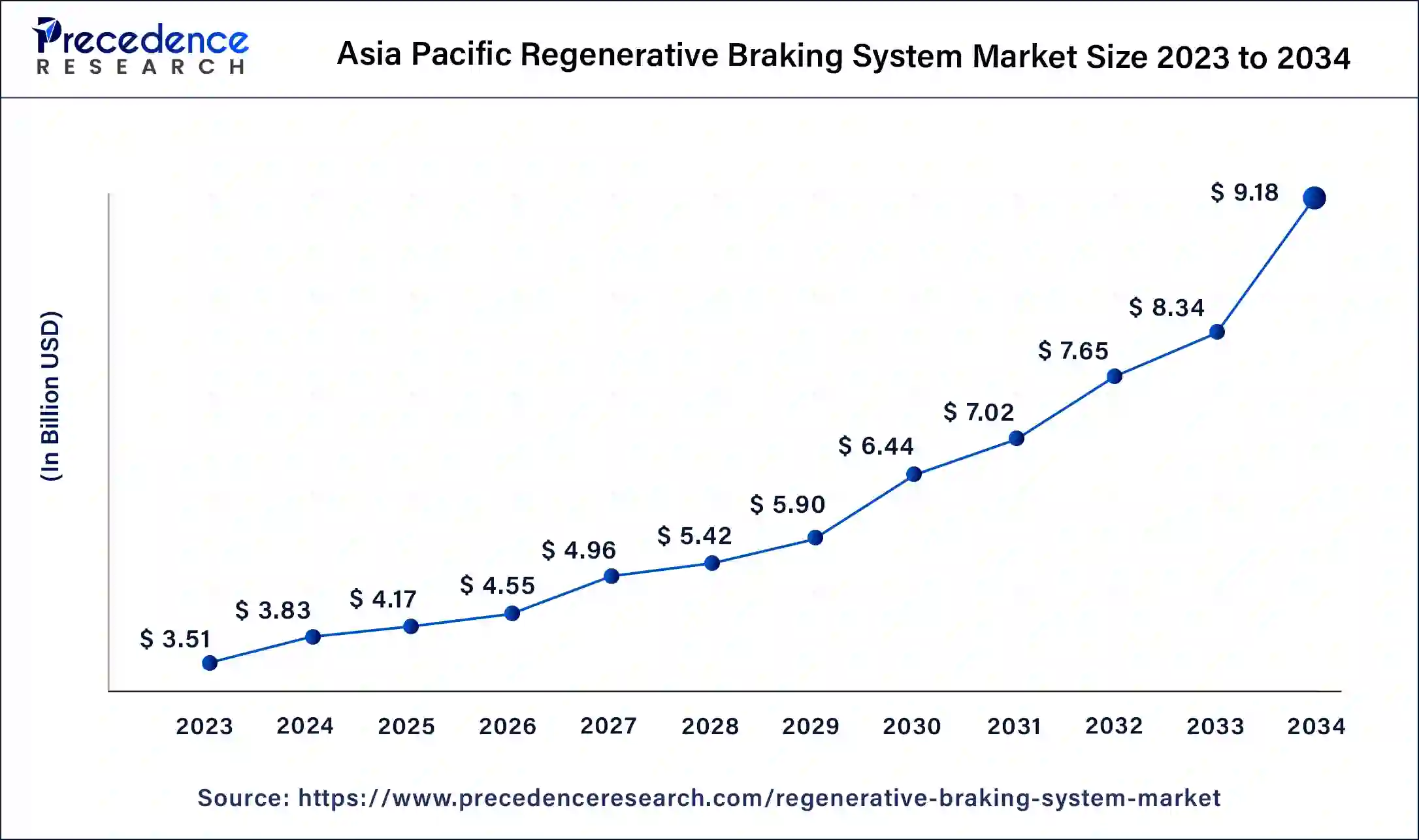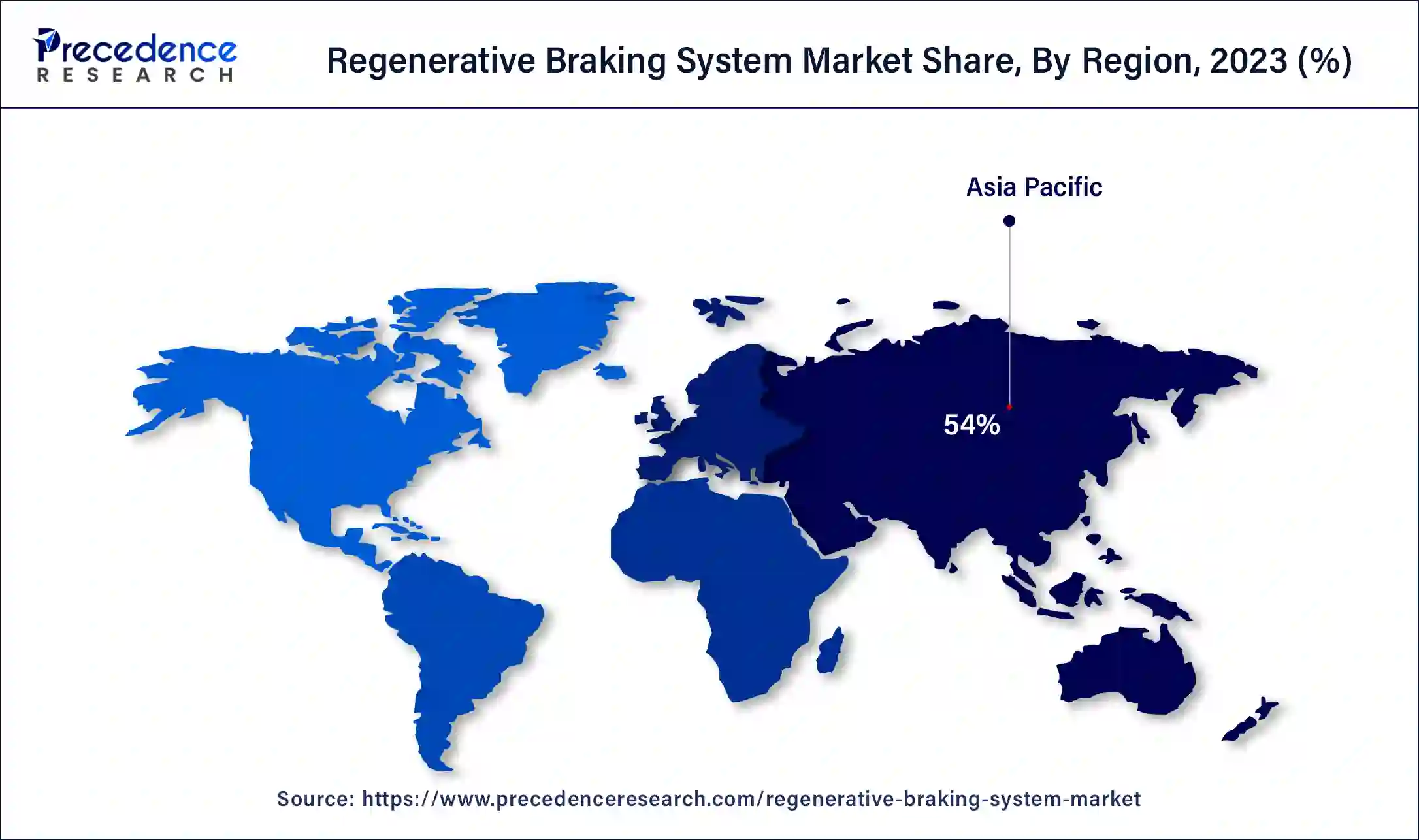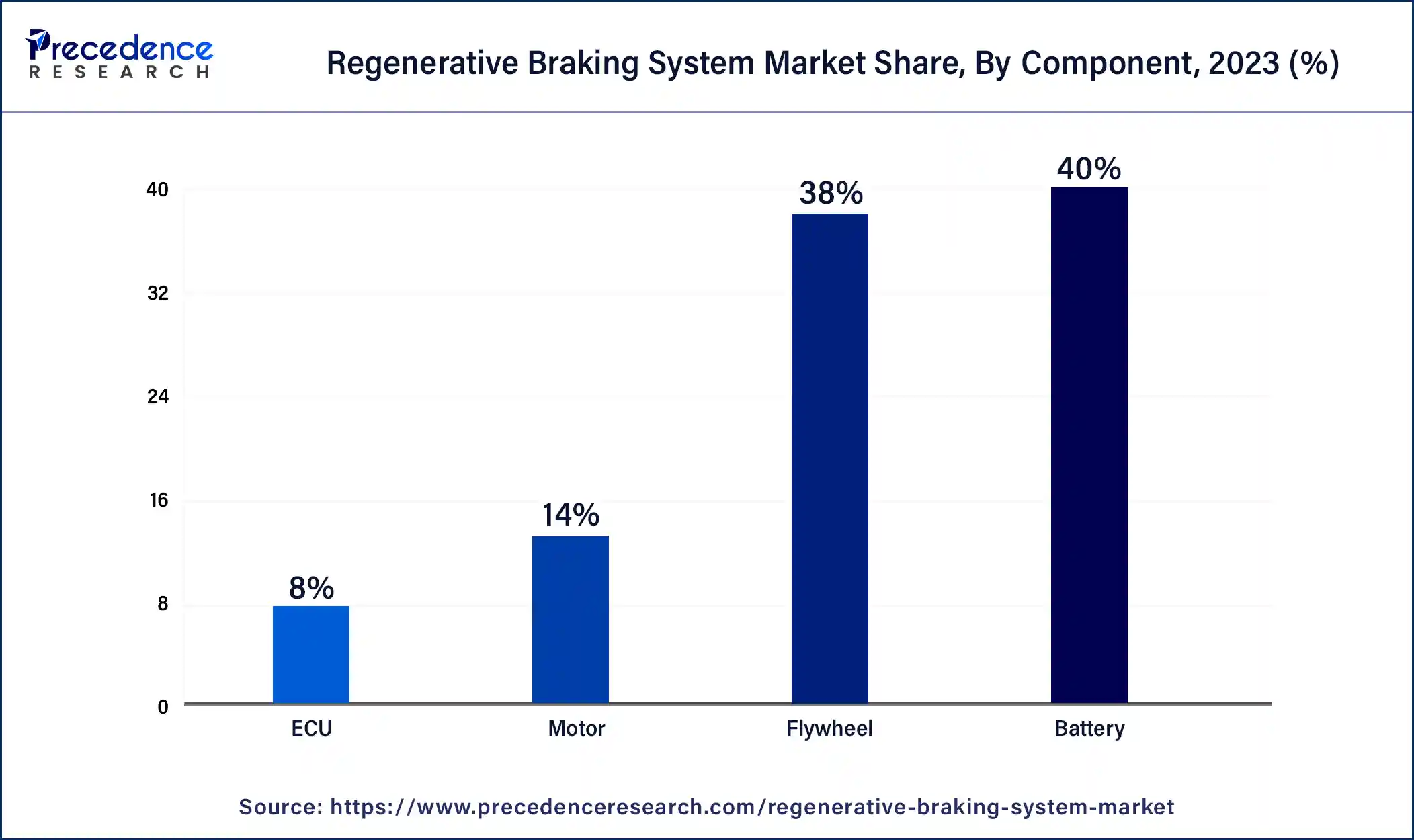List of Contents
Regenerative Braking System Market Size and Forecast 2025 to 2034
The global regenerative braking system market size is projected to be worth around USD 16.85 billion by 2034 from USD 7.09 billion in 2024, at a CAGR of 9.04% from 2025 to 2034. The increasing adoption of EVs and the aim to mitigate GHG emissions worldwide are expanding the regenerative braking system market.

Regenerative Braking System Market Key Takeaways
- The global regenerative braking system market was valued at USD 7.09 billion in 2024.
- It is projected to reach USD 16.85 billion by 2034.
- The market is expected to grow at a CAGR of 9.04% from 2025 to 2034.
- Asia Pacific dominated the global regenerative braking system market with the highest market share of 54% in 2024.
- North America is estimated to grow significantly in the market during the forecast period.
- By component, the battery segment has contributed more than 40% of market share in 2024.
- By component, the motor segment is expected to grow at the fastest rate in the market over the study period.
- By propulsion, the BEV segment held the highest share of the market in 2024.
- By propulsion, the PEV segment is registered as the fastest-growing segment in the global market.
- By vehicle type, the passenger car segment held the largest market share of the global market in 2024.
- By vehicle type, the HCVs segment is expected to witness the fastest growth in the market during the foreseen period.
Asia Pacific Regenerative Braking System Market Size and Growth 2025 to 2034
The Asia Pacific regenerative braking system market size was exhibited at USD 3.83 billion in 2024 and is projected to be worth around USD 9.18 billion by 2034, poised to grow at a CAGR of 9.13% from 2025 to 2034.

Asia Pacific held the largest share of the global regenerative braking system market in 2024. The dominance of this region is due to economically emerging countries like China, India, and Japan, as well as their automotive industrial expansion. These countries are considered major hubs for the production and sales of various types of automobiles.
The growing disposable income of the middle-class population and the rapid pace of urbanization have led to rising demand for passenger cars and HCVs in these countries, further expanding the regenerative braking system market. Additionally, the presence of key manufacturers and substantial investment to develop the automotive sector supported by government subsidies and incentives propel the global regenerative brakes system market further.

North America is estimated to grow significantly in the regenerative braking system market during the forecast period. The growth of this region is attributed to various factors, including awareness to reduce CO2 emissions for retrieving environmental balance, higher adoption of hybrid vehicles and EVs, and government stringent regulations for the automotive sector in North America, fuelling the regenerative braking system market on a wider scale.
North America has a strong emphasis on mitigating carbon emissions, pushing automakers to integrate advanced technologies that help reduce carbon emissions, such as regenerative braking systems, into their vehicles. Again, due to the increased awareness, the rising consumer demand for fuel-efficient and climate-friendly vehicles coupled with robust, well-established automotive infrastructure contributes to the region's growth on a global scale for the regenerative braking system market.
Market Overview
The global regenerative braking system market is anticipated to witness a substantial growth rate during the forecasted years due to various reasons. The market is fuelled by the rising adoption of EVs and hybrid vehicles, where regenerative braking systems play a crucial role in energy saving and, therefore, help reduce carbon emissions. The regenerative brake system converts kinetic energy into electrical energy while applying brakes to the vehicle. These are the key points that help to save energy and increase vehicle efficiency.
The increasing demand for fuel-efficient vehicles and eco-friendly vehicles is the major driving factor of the global regenerative braking system market. The market faces barriers due to factors like substantial initial cost and the necessity for robust infrastructure for electric vehicles. However, ongoing innovations and technological revolutions are set to limit these barriers and hold the potential to expand the market further on a wider scale.
AI Impact on the Market
AI has a significant impact on the regenerative braking system market, and it is continuing to evolve with cutting-edge technologies that aid in enhancing the overall efficiency, reliability, and ease of adoption in hybrid and electric vehicles. To optimize the energy recovery process, the artificial intelligence (AI) system can be integrated with a regenerative braking system by analyzing the patterns of driving the vehicle, conditions of the road, and dynamics of the particular vehicle while working. This allows vehicles to adapt to performance-based conditions, improving overall regenerative braking system efficiency.
Additionally, AI can predict the potential failures and critical areas to look after before its actual failure since it is able to monitor the braking system continuously without a time gap with the help of various sensors. Such a capability of predictiveness enables regenerative braking systems to work for a longer span of time. AI can again be integrated into more sophisticated systems for vehicles, such as powertrain control and battery management, for efficient operation.
Regenerative Braking System Market Growth Factors
- Increasing adoption of fuel-efficient electric vehicles and hybrid vehicles on a global level fuels the regenerative braking system market further.
- Governments stringent regulations to control excessive emission of greenhouse gases to recover climate collapses.
- Incentives provided by the government for higher adoption of EVs.
- Ongoing technological advancement for the improvement of regenerative braking systems.
- Rising customer demand for fuel-efficient vehicles to reduce fuel consumption.
- Increasing traffic congestion due to the rapid pace of urbanization requires fuel-efficient vehicles with regenerative braking systems to aid in fuel saving.
- Increasing awareness about climate change due to the excessive emission of CO2 by the automotive sector.
- Original equipment manufacturers are increasingly focusing on developing compact and lightweight regenerative braking systems.
- Integration of two-wheeler EVs and regenerative braking systems again aid in the regenerative braking system market expansion.
Market Scope
| Report Coverage | Details |
| Market Size by 2034 | USD 16.85 Billion |
| Market Size in 2025 | USD 7.73 Billion |
| Market Size in 2024 | USD 7.09 Billion |
| Market Growth Rate from 2025 to 2034 | CAGR of 9.04% |
| Largest Market | Asia Pacific |
| Base Year | 2024 |
| Forecast Period | 2025 to 2034 |
| Segments Covered | Component, Propulsion Type, Vehicle Type, and Regions |
| Regions Covered | North America, Europe, Asia-Pacific, Latin America, and Middle East & Africa |
Market Dynamics
Driver
Rising demand for fuel-efficient vehicles globally
One of the major key drivers for the regenerative braking system market is the constantly increasing demand for fuel-efficient and climate-friendly vehicles. Regenerative braking systems present an excellent opportunity for this goal of fuel-efficient vehicles, and thus, manufacturers investing heavily into the research and development of regenerative braking systems that capture the kinetic energy while braking application and convert it into electric energy, which is then stored into batteries installed in the system, that energy would otherwise be lost, is the key player of this system.
Regenerative braking technology extends the driving range of the vehicle as it provides fuel efficiency. Again, the global push towards sustainable driving practices with environment-friendly diving systems is the major driver that helps grow the regenerative braking system market on a global scale.
Restraint
Substantial initial investment
The major restraining factor for the proliferation of the regenerative braking system market is the high initial cost. Integration of such advanced technologies into the predetermined layout of the automobile requires significant changes in the structure of the automobile and its internal system, which results in substantial initial investment, and this cost can be a hindrance for the automakers where budget is the constraint. Additionally, these systems are very complex in nature, so they require a special skill set to make them work properly.
The maintenance cost of a regenerative braking system is much higher than the conventional cost for general vehicles, which further increases the load on resources. Such factors can deter some automotive manufacturers from embracing the latest technology of regenerative braking systems for vehicles. Therefore, in a nutshell, high maintenance leads to a substantial initial investment due to its system complexity, which is the major barrier to the proliferation of the regenerative braking system market.
Opportunity
Adoption of EVs on a wider scale
A significant opportunity that the regenerative braking system market holds is the increasing adoption of EVs, and commercial vehicles worldwide aim to have the lowest possible emission of GHG to reduce the carbon footprint from the climate, as cities are embracing the transition into greener public transportation movement to fight against rising air pollution and to mitigate its adverse effect on the overall human health that is reducing the quality of life. Vehicles that frequently start and stop are in greater need of a regenerative braking system since they can hold the potential to capture the kinetic energy of braking and convert it into electric energy to store further.
Moreover, the integration of regenerative braking systems into public transport can enhance energy-efficient traveling and reduce operational costs by reducing the frequent need for recharging while increasing the battery life. The rising investment in urban mobility solutions and embracing electric energy by logistics fleets represent significant growth opportunities for the regenerative braking system market.
Component Insights
The battery segment dominated the regenerative braking system market in 2024. The growth of this segment is related to various factors, including batteries, which are the storehouse of regenerative energy; hence, they play a critical role as a component of EVs and regenerative braking systems.Advancements in battery technology, like high energy density and fast charging capacity, again help drive the market on a global level.

The motor segment is expected to grow at the fastest rate in the regenerative braking system market over the study period. The motor has a major role in the regenerative braking system since it's the main component that converts kinetic energy into electrical energy during applied brakes. As the demand for hybrid and EVs is increasing in the market, the motors that can exceptionally handle regenerative braking processes are further proliferating. Also, advancements in motor designs, such as compactness and extended robustness, further fuelling the growth of the regenerative braking system market on a global scale.
Propulsion Insights
The BEV segment held the highest share of the regenerative braking system market in 2024. The growth of this segment is a total dependency on electric propulsion on the batteries. The rise in BEV adoption is due to the increasing concern for environmental damage due to excessive emission of GHG by the automotive sector, advancement in battery technology, government support, and incentives for the adoption of EVs. Also, the ongoing development of charging infrastructure is solidifying the leadership of the BEVs segment in the global regenerative braking system market.
The PEV segment is registered as the fastest-growing segment in the global regenerative braking system market. PEV stands for plug-in electric vehicles. The growth of this segment is due to its capacity for supporting dual modes of operation on both electric power using batteries and conventional methods of fuelling the vehicle. For shorter trips, electric power mode is useful, and for longer trips, both methods provide a sense of security while driving the vehicle, which is fuelling this segment's growth and, in turn, helps the regenerative braking system market.
Vehicle Type Insights
The passenger car segment held the largest regenerative braking system market share of the global market in 2024. The growth of this segment is due to the increased demand for personal vehicles, as they provide convenience and a sense of comfort and security while allowing flexibility to travel anytime. For this, the rapid adoption of automakers to integrate the enhanced regenerative braking system intohybrid vehicles and EVs for maximum range capacity further propels this segment's growth on a large scale.
The HCVs segment is expected to witness the fastest growth in the regenerative braking system market during the foreseen period. HCVs stand for heavy commercial vehicles. The HCVs segment is expanding due to the large adoption of regenerative braking systems into vehicles like buses and trucks as they provide fuel efficiency, which is helpful for longer journeys. Such heavy vehicles have substantial kinetic energy, which can be converted into electrical energy and used for traveling purposes.
As the government's rules have become stricter with ongoing days to reduce GHG emissions, many fleet operators and manufacturers of automotive s are turning towards the adoption of regenerative braking systems.
Regenerative Braking System Market Companies
- Robert Bosch GmbH (Germany)
- Denso Corporation (Japan)
- Continental AG (Germany)
- ZF Friedrichshafen AG (Germany)
- BorgWarner Inc. (U.S.)
- Hyundai Mobis (South Korea)
- Eaton (Ireland)
- Brembo S.P.A (Italy)
- Skeleton Technologies GmbH (Germany)
- Advices Co. Ltd. (Japan)
Recent Developments
- In January 2022, Advics Co., Ltd. declared that its Electric Parking Brake (EPB) and the regenerative coordinated braking system would be supplied for the GAC Group's GS8 hybrid vehicle. This is the first time Advics' products will be provided to the GAC Group model, and the adoption was based on the company's market experience and performance in electrification products.
- In April 2022, Brembo was announced as the main supplier of whole brake caliper assembly by Faraday Future Intelligent Electric Inc. for its FF 91 EV model. Brembo will be providing specialized caliper assembly for the FF 91.
Segments Covered in the Reports
By Component
- Battery
- Motor
- ECU
- Flywheel
By Propulsion Type
- BEV
- PHEV
- FCEV
By Vehicle Type
- Passenger Car (PC)
- Light Commercial Vehicle (LCV)
- Heavy Commercial Vehicle (HCV)
By Geography
- North America
- Asia Pacific
- Europe
- Latin America
- Middle East & Africa
For inquiries regarding discounts, bulk purchases, or customization requests, please contact us at sales@precedenceresearch.com
Frequently Asked Questions
Ask For Sample
No cookie-cutter, only authentic analysis – take the 1st step to become a Precedence Research client